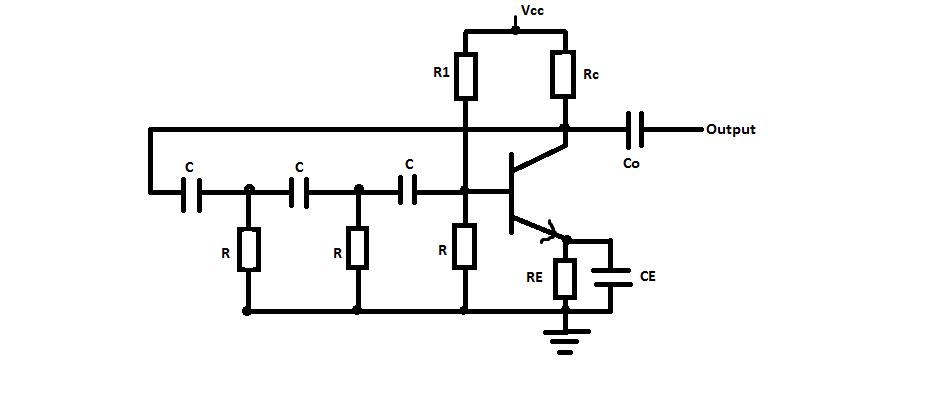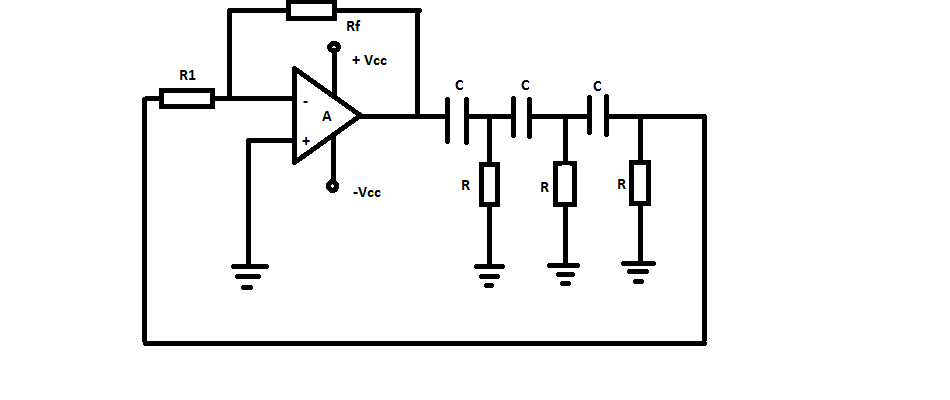An oscillator is used to produce periodic oscillating signals in an electronics circuit. The oscillations are mainly produced in the form of a square wave or sine wave. The oscillators can convert DC to AC and used in a number of electronic devices like clock generators, digital instruments like calculators. The oscillating signals are used in television transmitters, wall clocks, radios, and many more. A feedback oscillator is a type of oscillator in which the output signal is feedback into the input to provide positive feedback. These oscillators are classified according to the frequency selective filters that are used in the feedback network. An RC oscillator is a type of feedback oscillator where the filter is made up of a network of capacitors and resistors.
What is the RC Oscillator?
Definition: An RC oscillator is basically a type of feedback oscillator which consists of a transistor, an amplifying device, a vacuum tube, and an op-amp. This device also consists of a network of resistors & capacitors which form an RC network. The RC network is used to achieve positive feedback which generates an oscillating sinusoidal voltage. These oscillators are mainly used to produce lower frequencies like audio frequencies.
Such types of devices are extensively used as audio signal generators in electronic musical instruments. The output oscillations are generated because of the phase shift between the stages of the RC oscillator. The phase of the RC Oscillator is shifted 180 degrees through the feedback circuit. RC Oscillators can be implemented using an om-amp, a BJT, or a FET. There we have discussed the working and implementation of om-amp using an om-amp and a BJT.
Working Principle
An RC oscillator consists of an RC network which can be used to bring about a phase shift which is required by the response signal. This kind of oscillators has excellent frequency strength. They can also produce a pure sine wave as output which can be used for a large range of loads.
In order to produce oscillations, a total phase shift of 360 degrees must be present in the circuit. The amplifier produces a phase shift of 180 degrees and the RC phase shift network produces another 180 degrees phase shift. Hence, a phase shift of 360 degrees is achieved which is also equal to zero degrees.
RC Phase Shift Oscillator using BJT
A transistor can be used as an active element in the amplifier stage of the RC Phase Shift Oscillator circuit. The figure given below shows an RC oscillator circuit where the transistor has been used as an active element.

RC Phase Shift Oscillator using BJT
The active region of the transistor has been established by the resistors R1, R2, RC, RE, and the supply voltage Vcc. The bypass capacitor used in the circuit is CE. All the three RC sections are identical. The resistance produced in the last section of the circuit is R’=R-hie. Here, ‘hie’ is the input resistance which is added to R’ so that the net resistance of the circuit becomes R.
The biasing resistors like R1 and R2 have a very large value and hence have no effect on the AC operation. Also, the RE-CE combination offers negligible impedance to the circuit and it also has no effect on the AC operations. When the power supply is given to the circuit, the noise voltage will start the oscillations. The base current is capable of producing a current which has a phase shift of 180 degrees.
When this signal is again given as a feedback to the input terminal of the amplifier, then the signal will again be phase-shifted by 180 degrees. When the loop game becomes unity, then sustained oscillations will be produced in the circuit.
The frequency of oscillations is given by:
f = 1/ (2 π R C √ ((4Rc / R) + 6))
If Rc/R << 1, then
f= 1/ (2 π R C √ 6)
For sustained oscillations, the condition is:
hfe (min) = (4 Rc/ R) + 23 + (29 R/Rc)
In case of a phase shift oscillator which has R = Rc, the value of ‘hfe’ must be 56 in order to attain sustained oscillations.
From the above equations, we can see that if we wish to change the frequency of oscillations, the value of ‘R’ and ‘C’ will have to be changed.
RC Oscillator using Op-amp
The Op-amp RC oscillators are more commonly used as compared to transistorized oscillators. The RC Phase Shift oscillator consists of an operational amplifier as the amplifier stage. It also has three cascaded RC networks which form the feedback circuit. The figure below shows an RC Oscillator circuit using Op-amp.

RC Oscillator using Op-amp
The operational amplifier is used in the inverting mode and the output signal is phase-shifted by 180 degrees to the input signal. An additional 180 degrees phase shift is obtained because of the RC feedback network. Hence, all the conditions are satisfied and oscillation is produced. The gain of the op-amp can be adjusted with the help of R1 and R2 resistors. In order to achieve the required oscillations, we will have to adjust the gain in such a way that the product of gain of feedback and om-amp gain is always slightly greater than 1.
The frequency of oscillations is given by:
1/ (2 π R C √ 6)
The condition of oscillations: A ≥ 29.
Applications
The applications of an RC oscillator include the following.
- RC oscillators can be used to generate signals having a huge range of frequencies.
- They are used extensively in voice synthesis and musical instruments.
- RC oscillators are also used in GPS units.
Please refer to this link to know more Oscillators MCQs
FAQs
1). What is the main function of RC Oscillators?
The main function of RC oscillators is to generate a huge range of frequencies.
2). What kind of feedback is used in the RC phase shift oscillator?
In RC Phase Shift Oscillators, a positive feedback network is used.
3). What are the advantages of RC Oscillators over LC oscillator?
An RC Oscillator circuit is easy to design and it is also capable of producing sinusoidal waveform.
4). Why are oscillators used in circuits?
Oscillators are used in circuits to produce periodic oscillating signals. It is used in various electronic devices.
5). What is the main disadvantage of the RC Oscillator?
The main disadvantage of RC Oscillators is that the frequency stability becomes extremely poor in case there is a change in temperature.
Please refer to this link to know more about LC Oscillator.
Thus, this is all about an overview of the RC oscillator. It is an extremely important electronic component from an industrial point of view and has a wide number of applications. What, according to you, is the main application of RC Phase Shift Oscillators?